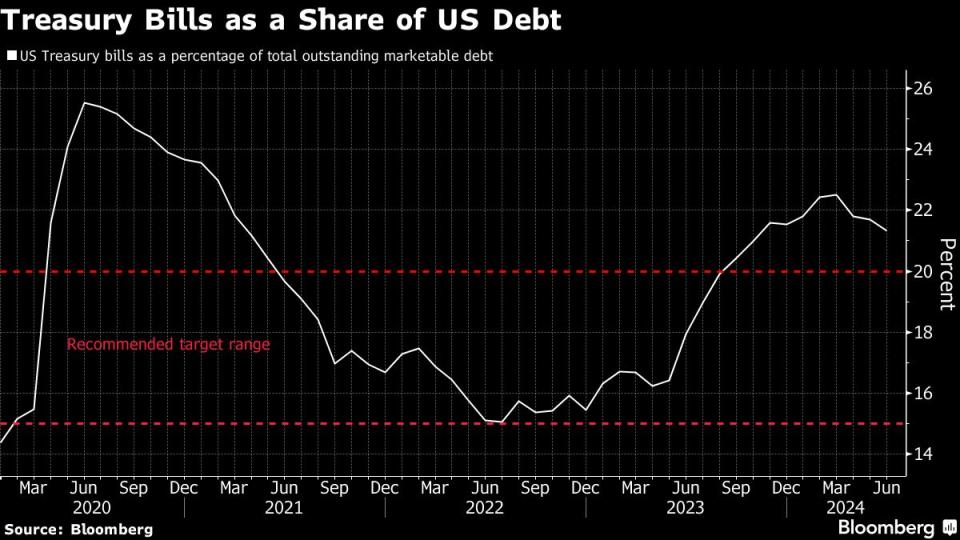US Treasury Counters ‘Misconceptions’ Over Debt-Sales Strategy
(Bloomberg) -- The top US Treasury official overseeing sales of federal debt securities is set to push back Thursday against claims that the Biden administration has departed from long-standing issuance practices over the past year.
Most Read from Bloomberg
Saudis Warned G-7 Over Russia Seizures With Debt Sale Threat
Tesla Delays Robotaxi Event in Blow to Musk’s Autonomy Drive
Stock Rotation Hits Megacaps on Bets Fed Will Cut: Markets Wrap
Saudi Prince’s Trillion-Dollar Makeover Faces Funding Cutbacks
Modi’s Embrace of Putin Irks Biden Team Pushing Support for Kyiv
Josh Frost, the Treasury Department’s assistant secretary for financial markets, will offer what amounts to the most extensive discussion of the issuance of Treasuries — the world’s largest fixed-income market, where some $900 billion of securities are traded on average each day — in well over a decade.
“We issue securities in a regular and predictable fashion as part of our strategy to borrow at the lowest cost over time,” Frost said in remarks prepared for an event Thursday evening that were seen by Bloomberg. “This mission statement has existed for several decades, and we never lose sight of that north star,” he said, countering claims that, under Treasury Secretary Janet Yellen, issuance strategy has shifted from past norms.
Frost’s address to the Money Marketeers, a forum on markets dating back to 1946, comes against a backdrop of strong criticism from a number of Republicans and prominent market participants that Yellen and her aides have handled debt sales improperly.
Scott Bessent, the founder of Key Square Group LP and a fundraiser for former President Donald Trump, said last month that the Treasury’s decision last November to slow its increase in sales of longer-term Treasuries was designed to loosen financial conditions and juice the economy in the run-up to the presidential election. By instead relying on a rise in the share of short-dated bills to fund the government, the Treasury has effectively crowded out small businesses — which tend to borrow more at shorter maturities — David Malpass, the former World Bank president named to that post by Trump, said in May.
Frost hit back in his prepared remarks, aimed at “debunking common misconceptions.” He emphasized that the slowdown in growth of longer-term debt sales last November was a tiny shift, that the increase in the share of bills in issuance was in line with past practice of using them as a “shock absorber,” and that the Treasury’s long-standing mantra governing securities sales didn’t mean changes cannot occur.
“Regular and predictable issuance doesn’t mean that Treasury steadfastly ‘stays the course’ even when presented with new information and situations,” Frost said.
Treasury yields surged over the August to September period, in part due to concerns about heavy US borrowing requirements. The department then in November announced a $112 billion so-called quarterly refunding round of sales of 3-, 10- and 30-year Treasuries, slightly less than the $114 billion many dealers expected.
Frost highlighted that the slowdown in added issuance of 10-, 20- and 30-year securities amounted to roughly a 1% change. “This kind of modest adjustment is exactly what the regular and predictable framework calls for. This was not outside of any norms,” he said. “This was driven by Treasury’s views of structural demand and updates to expected borrowing needs.”
By contrast, more than half a century ago the US used to adjust sales on an ad hoc basis. Smaller nations today effectively attempt to market-time, ramping up sales of securities that investors have a particular appetite for. The US abandoned that mindset in the 1970s, when deficits climbed.
Since then, the philosophy has been that maintaining a transparent, predictable issuance pattern is the best way to ensure the lowest cost to taxpayers over time — ensuring a broad investor base and promoting a liquid market where dealers can easily trade, Frost said. This also helps Treasuries serve as a global benchmark, for both investors and other issuers, he said.
Frost’s comments were the most extensive discussion from a policymaker on US debt issuance strategy since a 2007 paper by the Federal Reserve’s Kenneth Garbade.
As for the rise in the share of bills in US debt outstanding, Frost rebutted the idea that the Yellen team had somehow violated guidelines to keep the share in a 15%-to-20% range.
That range was suggested by the Treasury Borrowing Advisory Committee, or TBAC — a panel of dealers and investors that has been advising the government on issuance strategy for decades.
Frost reiterated in his prepared speech that the department thinks of the 15-to-20% range as a useful rule of thumb, but not a hard and fast mandate.
Since 1980, the bills share has been as high as 36% and as low as 10%, and has only been in the 15%-to-20% range about 13% of the time, Frost detailed. That’s because bills are a “shock absorber” for ebbs and flows in borrowing needs over each quarter.
He highlighted that TBAC itself had said last year that it was “comfortable running T-bills in the range of their longer-term historical share of 22.4% for some time” before returning to the 15%-to-20% range.
“Being regular and predictable provides a framework for making changes in the least disruptive way possible, which minimizes risks to investors and ultimately translates into lower borrowing costs for Treasury,” Frost said.
Most Read from Bloomberg Businessweek
Ukraine Is Fighting Russia With Toy Drones and Duct-Taped Bombs
At SpaceX, Elon Musk’s Own Brand of Cancel Culture Is Thriving
©2024 Bloomberg L.P.

 Yahoo Finance
Yahoo Finance 

